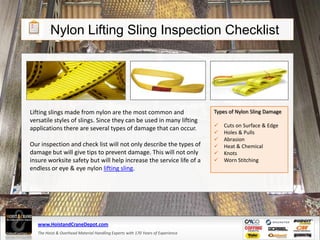
Nylon Web Slings Inspection Checklist
- 1. Nylon Lifting Sling Inspection Checklist Lifting slings made from nylon are the most common and versatile styles of slings. Since they can be used in many lifting applications there are several types of damage that can occur. Our inspection and check list will not only describe the types of damage but will give tips to prevent damage. This will not only insure worksite safety but will help increase the service life of a endless or eye & eye nylon lifting sling. www.HoistandCraneDepot.com The Hoist & Overhead Material Handling Experts with 170 Years of Experience Types of Nylon Sling Damage Cuts on Surface & Edge Holes & Pulls Abrasion Heat & Chemical Knots Worn Stitching
- 2. Surface and Edge Cuts Lifting Sling Damage Inspection Surface and Edge Cuts Damage: It is important to realize that all of the fibers in web slings contribute to the strength of that sling. When there have been a significant number of fibers broken in a nylon web sling, as shown here, that sling should be taken out of service. What To Inspect: Broken fibers of equal length indicate that the sling has been cut by an edge. Red core warning yarns may or may not be visible with cuts and are not required to show before removing slings from service. Prevention: Always protect synthetic slings from being cut by corners and edges by using wear pads or other devices. www.HoistandCraneDepot.com The Hoist & Overhead Material Handling Experts with 170 Years of Experience
- 3. Snags, Pulls, & Holes Lifting Sling Damage Inspection Snags, Holes, & Pulls Damage: A web sling may have a small hole, snag, or pull in the nylon that can affect the strength and integrity of the sling during lifting. What To Inspect: Punctures or areas where fibers stand out from the rest of the sling surface. Prevention: Avoid sling contact with protrusions, both during lifts and while transporting or storing. www.HoistandCraneDepot.com The Hoist & Overhead Material Handling Experts with 170 Years of Experience
- 4. Abrasion Lifting Sling Damage Inspection Abrasion Damage: Since nylon slings can be used for many different lifting applications many of these materials can be abrasive. The rubbing of a rough object against a sling can cause it to fail over time. What To Inspect: Areas of the sling that look and feel fuzzy indicate that the fibers have been broken by being subject to contact and movement against a rough surface. Affected areas are usually stained. Prevention: Never drag slings along the ground. Never pull slings from under loads that are resting on the sling. Use wear pads between slings and rough surface loads. www.HoistandCraneDepot.com The Hoist & Overhead Material Handling Experts with 170 Years of Experience
- 5. Chemical and Heat Lifting Sling Damage Inspection Chemical & Heat Damage: Nylon is similar to plastics that when come in contact with heat or certain chemicals it can cause damage to the structural integrity of a sling. What To Inspect: Melted or charred fibers anywhere along the sling. Heat and chemical damage can look similar and they both have the effect of damaging sling fibers and compromising the sling's strength. Look for discoloration and/or fibers that have been fused together and often feel hard or crunchy. Prevention: Never use nylon or polyester slings where they can be exposed to temperatures in excess of 200° F. Never use nylon or polyester slings in or around chemicals without confirming that the sling material is compatible with the chemicals being used. www.HoistandCraneDepot.com The Hoist & Overhead Material Handling Experts with 170 Years of Experience
- 6. Knots Lifting Sling Damage Inspection Knots in Sling Damage: These compromise the strength of all slings by not allowing all fibers to contribute to the lift as designed. Knots may reduce sling strength by up to 50%. What To Inspect: Knots are rather obvious problems as shown in the image to the left. Prevention: Never tie knots in slings and never use slings that are knotted. www.HoistandCraneDepot.com The Hoist & Overhead Material Handling Experts with 170 Years of Experience
- 7. Broken and Worn Stitching Lifting Sling Damage Inspection Worn & Broken Stitching Damage: The main stitch patterns of web slings has a direct adverse effect on the strength of a sling. The stitch patterns in web slings have been engineered to produce the most strength out of the webbing. What To Inspect: Loose or broken threads in the main stitch patterns. Prevention: Never pull slings from beneath loads where stitch patterns can get hung up or snagged. Never overload the slings or allow the load edge to directly contact the stitch pattern while lifting. Never place a sling eye over a hook or other attachment whose width/diameter exceeds 1/3 the eye length. www.HoistandCraneDepot.com The Hoist & Overhead Material Handling Experts with 170 Years of Experience
- 8. Nylon Lifting Sling Products If you find that you need to replace your nylon lifting sling we can help. Our expect staff just has hands on field experience that can help you identify the right nylon sling for your application. Buy directly online or have us custom configure a nylon sling for you N y l o n S l i n g P r o d u c t s Eye & Eye Nylon Lifting Slings: 1” Endless Nylon Lifting Slings: 1” to 3” inch widths and 1,2,& 3 Piles to 6” inch widths and 1,2,& 3 Piles Additional Types: Polyester Slings Chain Link Slings Wire Rope Slings Lifting Sling Regulations and Standards : OSHA Regulations and Sling Standards www.HoistandCraneDepot.com The Hoist & Overhead Material Handling Experts with 170 Years of Experience
